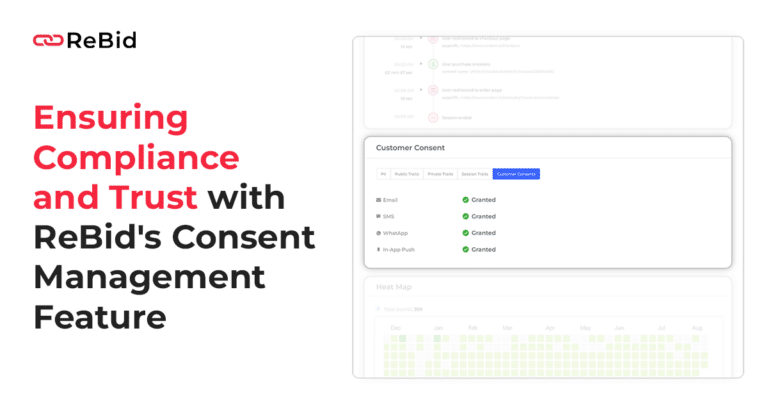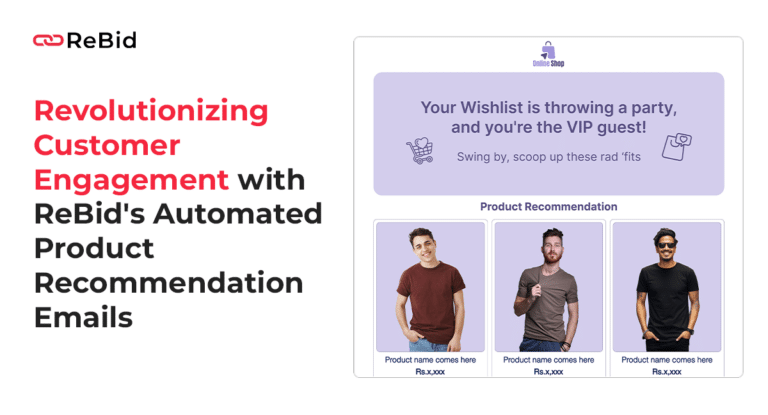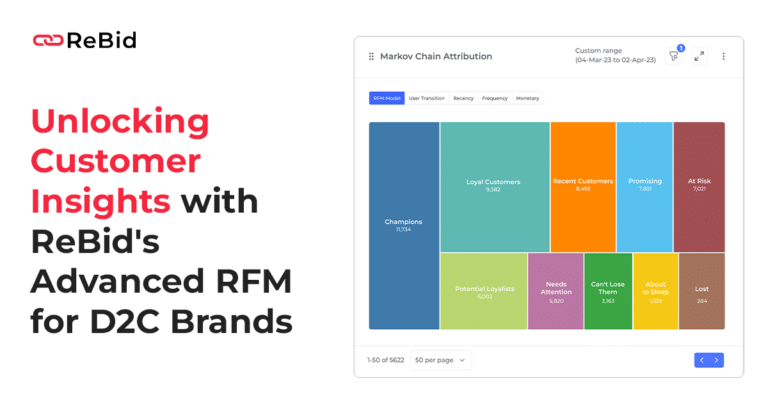The vocabulary around digital advertising and ad campaigns is evolving at a swift pace. Just within AdTech and MarTech, there are a plethora of concepts you will need to navigate.
And sometimes, these concepts can get daunting. But why worry when ReBid is here to help you decode AdTech and MarTech Terms
AdTech and MarTech Terms
What are Demand Side Platforms (DSPs)?
Before the era of automation, buyers and salespeople would connect, negotiate, and come to a mutual price for digital ad space. This process was time-consuming and expensive.
So, is there an opportunity to automate? Yes!
And, DSPs are automated tools that help you get there. They buy advertising space with minimal human involvement.
Basically, these platforms allow media buyers to run online advertising campaigns and buy inventory from publishers (websites or apps) via various ad exchanges and supply-side platforms (SSPs) through one user interface. Naturally, DSPs are a key component of the real-time bidding (RTB). Often, they use data from DMPs (Data Management Platforms) to optimize campaign performance. E.g. increase or decrease the bid price based on information in bid requests from supply side entities.
In short, negotiations, finalizing orders, sending purchase confirmations, and all other steps in buying ad space digitally are automated through DSP and completed within seconds.
Example:
Let’s say you run a chain of multi-brand gift stores. Christmas is an important time for your business. You reach out to a DSP, provide campaign details like creatives, your regions of interest, demographics of the target audience, maximum price you are willing to pay for the relevant adspaces available with publishers and so on.
Using a DSP, you will set up a campaign with the above details. You will bid for ad space on the site. The DSP will execute this contract as per the budget you assign.
If it is the highest bidder, it will win the auction. Then, the ads for your product will feature on the site.
Why you need DSPs in the modern MADtech ecosystem:
- Save time with quick and efficient bid processes. It takes only a few mili seconds (or less!) to wrap up an auction and buy the desired ad space
- Save money, especially by eliminating the need for human capital for manual negotiations.
- Manage campaigns on the go.
- Real-time reporting & analytics to validate and further optimise campaign performance.
What are Supply Side Platforms (SSPs)
SSPs are the other side of the AdTech coin which facilitate publishers to sell their inventories. Essentially, these platforms are a stack of ad spaces for sale belonging to various Web and App Publishers. So, they display vital information like ad size, price, location, etc.
Also, SSPs allow publishers to sell inventory to advertisers via a number of ad exchanges in an automated and efficient manner. Naturally, SSPs provide several benefits that allow publishers to get the most ROI from their inventory. Also, they help publishers gain sharper insights into their audience.
Just like DSPs, the need for human intervention is minimized. Also, SSPs can also be used for inventory tracking.
Example:
Google, an SSP, has the most sought-after ad spaces. It adds its available ad space to the marketplace (referred to as ad exchange), along with details about its visitors. You want to run your restaurant’s ad in various places during the Christmas and New Year holiday season. Your DSP bids for the Google ad space because it deems it suitable in terms of pricing, ad size, targeting etc
Your DSP’s bid is the highest. Subsequently, your ad features in that coveted Google Ad space.
How SSPs benefit the MadTech ecosystem:
- Boost your ad fill rates quickly and efficiently.
- Drive profits by streamlining the bidding process and accepting only relevant bids.
- Define floor prices to minimize losses.
What are Data Management Platforms (DMPs)?
Essentially, DMPs collect, classify and synthesize data to produce insights for publishers and businesses. Also, they optimize all the non-identifiable customer data, including anonymized elements such as cookies, data from ads and DSPs etc.
At its core, the objective of DMPs is to produce data sets pulled together from various sources. Also, these platforms present this data in a manner that other tools (such as DSPs) can process them.
DMPs serve ads and power retargeting using cookies. But, they focus more on anonymous cohorts and categories than single consumers. In a DMP, most data and info is anonymous and typically expires after 90 days, i.e. the lifetime of a cookie.
Example:
Your holiday gifting store needs a boost in sales this season as sales have been slow due to the pandemic the last couple of years. A DMP will collect data from sources such as gifting and lifestyle blogs, other lifestyle websites, Facebook posts about gifting and lifestyle, and so on, to generate an insight such as: “Women between 25-30 years old have been searching for a sustainable Christmas Tree” or “Men between the ages 35-40 have been looking for a pashmina shawl”.
Then, you can use this insight to target women within this demographic with desired promotions. This improves the probability of conversions.
The benefits of DMP in the MADtech ecosystem:
- Optimize the process of gathering insights by automating it. DMPs smoothly streamline data, and therefore customer targeting and behaviour prediction is easier.
- Achieve rich data sets due to data enrichment that brings in second party and third party data through audience extensions.
What are Customer Data Platforms (CDPs)?
In some ways, a CDP is similar to a DMP. But it collects and stores first-party data from various MarTech platforms. With CDP, marketers can manage all their customer data in one place, create audiences, and utilize these audiences in their ads and campaigns.
Naturally, CDPs run complementary to DMPs. The main difference is that a CDP can collect comprehensive first-party data and identifiable first-party insights about customers. It integrates this data into pliable datasets for efficient customer management and analytics. Therefore, CDP gives a 360-degree view of your entire customer base.
The CDP’s main job is to stitch together all the customer data into unified customer profiles. Advertisers can then optimize campaigns efficiently and effectively. A CDP ingests all types and sources of customer data – internal or external, structured or unstructured, batch or streaming. This allows advertisers to form a holistic view of their customers. CDP allows advertisers to act on this data, often in real-time.
Example:
Think about a customer who converted within minutes based on an ad they saw on their social media timeline. With a CDP, you have a deep insight into the conversion journey of each customer and can gauge that the customer took least time to convert. Therefore you can focus your ad efforts on that particular social media for higher ad revenue.
The many benefits of CDPs in MadTech ecosystem:
- Integrate customer data that would otherwise be stored in different silos due to cross-channel marketing.
- Monitor customer touchpoints and use the insights to enhance ad revenue.
- Enhance service usability with detailed customer analytics.
- Fill in the void left behind by cookie deprecation with the power of data from CDPs.
Creative Management Platforms (CMP’s)
All the advertising technologies, products, and processes for designing, circulating, and measuring ads are part of a CMP. A creative management platform, or CMP, is a cloud-based tool allowing advertisers to create, distribute, and measure the performance of digital advertising.
CMP is a variety of advertising technologies all rolled into one easy-to-use platform.
CMPs can be likened to a mini production agency for advertisers. It reduces time, maximises ROI, and enables advertisers to create personalised ads. CMPs also allow personalizing creatives to audience segments to enable message relevance. They allow these creatives to be refreshed or tested for optimization.
This cloud-based platform helps create and execute campaigns, from scaling images for the first cut of an ad to measuring the ROI of a finished campaign.
Example:
You work with a global conglomerate with many brands under their banner which function in the same niche. They want the holiday season messaging to be consistent across all their brands. Without a CMP, it is challenging to check for consistency across all these ads without manual intervention and collaboration between multiple marketing teams.
Within a CMP, the conglomerate can monitor the entire process right from the ideation stage and ensure a common thread runs through all their brand ads, and replicate the ones that do well.
What now?
It is hard to keep up with the new AdTech and MarTech Terms cropping up in the ecosystem. But with the right tech stack partner like ReBid, understanding and leveraging these terms and systems is hardly an uphill task.
If you want to ramp up your ad revenues and profits or enhance ROAS and optimize ad spend by contextualizing your business within the above domains, give us a shout! We’re here to help.





